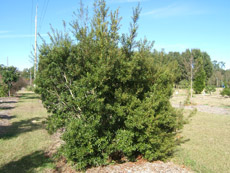Myrica cerifera (Southern Waxmyrtle)

*Click on picture for more images of this species.
- USDA Hardiness Zone: 7B - 10
- Mature Height: 15 to 20 ft
- Mature Spread: 20 to 25 ft
- Growth Rate: Very fast
- Availability: Generally available
- Drought Tolerance: Moderate
- Salt Tolerance: High
- Light Requirements: Full sun to partial shade.
- Native Origin: Native to Florida
- Soil Drainage: Tolerates well-drained sites to sites with extended flooding.
- Foliage: Evergreen tree with no showy fall color.
- Flowers: Green, not showy flowering in the spring.
- Pests: The main insect pests are caterpillars, mites and webworms. The main diseases are cankers and Fusarium, which causes a lethal wilt disease.
Description: Multiple, twisted trunks with smooth, light gray bark, aromatic, olive green leaves, and clusters of grey-blue, waxy berries on female plants which are attractive to wildlife are just some of the reasons Southern Waxmyrtle is such a popular landscape plant. Most specimens form a multi-stemmed, open, rounded canopy of weak trunks and branches. This rapidly-growing, small, evergreen native tree is capable of reaching a height of 25 feet with an equal spread but is usually seen in the 10 to 20-foot range. Sometimes used as a large shrubbery screen, Southern Waxmyrtle is ideal for use as a small tree, the lower limbs removed to reveal its picturesque form. One, or several clustered together, provide pleasing dappled shade for terraces or patios.
Very tough and easily-grown, Southern Waxmyrtle can tolerate a variety of landscape settings from full sun to partial shade, wet swamplands or high, dry and alkaline areas. Growth is thin in total shade. It is also very salt-tolerant, making it suitable for seaside applications. It is adapted to parking lot and street tree planting, especially beneath power lines, but branches tend to droop toward the ground, possibly hindering flow of vehicular traffic if not properly trained and pruned. Set them back from the road if used as a street tree so drooping branches will not hinder traffic. Trees are short lived making them a poor street tree choice.
Removing excess shoot growth two times each year eliminates the tall, lanky branches and reduces the tendency for branches to droop. Some landscape managers hedge the crown into a multi-stemmed dome-shaped topiary. Plants spaced 10 feet apart, maintained in this manner, can create a nice canopy of shade for pedestrian traffic. Plants should be watered well until established and will then require no further care. The only drawback to the plant is its tendency to sprout from the roots. This can be a nuisance as they need to be removed several times each year to keep the tree looking sharp. However, in a naturalized garden this thick growth could be an advantage, since it would provide good nesting cover for wildlife. Only female trees produce fruit provided there is a male nearby, but seeds do not appear to become a weed problem in the landscape.
Pruning appears to induce infection for Ptychogaster or Inonotus decay and possible Fusarium infection.
Gainesville Observations: Biggest draw back is the tree's short life. It makes a great tree for planting under power lines because trees will never grow to interfere. Growth in very rapid and foliage is attractive while the tree lives. Trees have a difficult time surviving more than 15 years.

